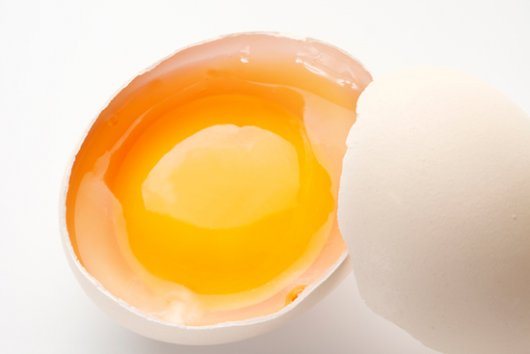What to look for when buying chicken eggs? What is the difference between dietary and canteen? How long can eggs be stored and how to avoid salmonellosis? 9 answers to the most popular questions about this product.
The first 7 days the egg is considered dietary, then it goes into the table category
How to read the stamp on an egg?
The letter “d” or “s” means, respectively, a dietary or table egg. The first sign on the stamp indicates the date - the day and month of the “birth” of the egg, the second - the category (and therefore its size).
What is the difference between a dietary egg and a table egg?
A diet egg (with a red stamp) differs from a table egg in its freshness. It must be implemented within 7 days from the moment of birth. Then, after a week, the egg goes into the table category. If the egg is initially doomed to a long life, long-term sales and, possibly, storage at sub-zero temperatures, a stamp is applied to it with blue ink.
How long can an egg last?
A table egg can be stored at room temperature for up to 25 days from the moment of “birth” and up to 90 days in the refrigerator.
The color of the eggshell does not in any way affect the taste or nutritional value of the product.
Which category of eggs is better?
The category is assigned to an egg depending on its weight and is usually indicated on a stamp or packaging.
- The third category is the smallest eggs (35–44.9 g).
- The second category is medium (45–54.9 g).
- The first category is large (55–64.9 g).
- Selected (denoted by the letter “o”) are the largest (65–74.9 g).
By the way, in culinary recipes an egg weighing 40 g is taken as one egg, that is, an egg of the third category.
White or dark?
Experts have no disagreement on this matter: the color of the eggs is just a tribute to the breed of the chicken. This is a purely aesthetic point that does not in any way affect the quality of the product.
What are "enriched eggs"?
“Smart” eggs with iodine, “fitness” eggs with selenium, and “vitamin” eggs are increasingly appearing in stores. Enrichment of eggs with various microelements occurs through the addition of appropriate preparations to the feed of laying hens. Whether such a product is useful for you or not is an individual question - if you do not know the level of iodine in your body, it is better not to experiment with eggs enriched with this element.
To avoid salmonellosis, it is recommended to boil the egg for at least 10 minutes.
What does it mean to say "organic" on egg packaging?
Abroad, the appearance of this word on product packaging is strictly regulated. It means that these are eggs from chickens that have the opportunity to freely range in natural fields under the sun, which are fed exclusively with natural feed, rich in chlorophyll, and in winter - seaweed. In our country, although a resolution on sanitary and hygienic requirements for organic products was adopted (in the summer of 2008), testing for compliance with the declared standards has not yet been carried out.
All that remains is to express gratitude to those manufacturers who themselves send their products for voluntary laboratory research, for example, to the Institute of Nutrition of the Russian Academy of Medical Sciences. In general, read the labels on the packaging more carefully.
How to protect yourself from salmonellosis?
- Cracked eggs should not be eaten.
- Before use, the egg should be washed with soap or soda (dried droppings are not at all a sign of an “organic” egg, but rather a consequence of poor hygiene at the poultry farm).
- Always wash your hands with soap if you handle eggs.
- Do not eat raw eggs or add them to dishes.
- It is recommended to boil eggs for at least 10 minutes.
What are the storage conditions for eggs?
Eggs are stored in a cool place away from strong-smelling foods and away from raw meat. The optimal temperature is 0–5°C. To protect them from foreign odors, use an airtight tray. Experts advise storing eggs with the pointy end down - otherwise the yolk, located on the air chamber of the egg, will begin to dry out faster.
wday.ru/food/advices/_article/9voprosov-iotvetov-okurinyx-yajczax/3/&pag=3
About nutrition: country egg and dietary egg
Readers: 159
Eggs purchased in city stores are labeled according to the standard. Do we know how to decipher incomprehensible symbols? It turns out that everything is simple. One symbol determines the category by weight, and the second divides it into table (C) and dietary (D).
After a chicken lays an egg, for the first seven days it is considered dietary, then - table. There is a secret to find out whether you have a diet egg in your palm or not. To do this, you need to lower it into water. Dietary food should lie on the bottom, and table food should hang in the water column. It remains to be tested in practice whether this is true. The biological value of eggs directly depends on the degree of freshness. Day after day, they gradually lose value: the protein liquefies, the yolk shell becomes thinner, and the content of vitamins and enzymes decreases.
There are other ways to determine the freshness of eggs. A newly laid dietary egg is covered with a shell that gives the shell a dull appearance. Then its thin layer is erased, and the shell becomes glossy. You can try to hold the blunt end of the egg up to the light to see if there is an air chamber. In a fresh product it is small and almost invisible; in a product that has been stored for some time, a round-shaped spot of a darkish hue can be seen. Eggs can remain in the refrigerator for up to three months, but they will lose their usefulness.
Village eggs don’t have a stamp, and you can’t buy them in a store either. Moreover, eggs from rural farmsteads are a seasonal product. Chickens lay eggs well only in the warm season. In winter, at poultry farms they are stuffed with special fertilizers for “normal” wear, but it is unlikely that the farmer will do the same, since he not only sells his products, but also consumes them himself.
Since the chickens in the village are accompanied by a rooster, all village products are real, fertilized. When producing dietary eggs, hens are kept in cages and roosters are not allowed near them. In terms of the brightness of the yolk, the rustic variety is no different from the dietary variety. Chickens in the village lay eggs with yolks of different shades, but the agricultural industry does not stand still, and producers already know what to add to the chicken’s diet to tint the yolk.
Smell and taste are perhaps the two main differences! Homemade eggs smell rich, but store-bought eggs lack the spirit of freedom and health. The difference in taste cannot be described in words. Homemade rustic items are more expensive and cannot be bought everywhere. It’s up to you to decide what products to consume, village ones from the market or dietary ones from a nearby supermarket. But natural village ones are more tasty, nutritious and healthy.
Diet egg for weight loss
Today, a great many diets are based on eggs. There is even a study that shows that eating eggs for breakfast can reduce your appetite at lunch and dinner. Everyone knows the egg-based diet plan. But is it worth it to abuse eggs, because many nutritionists do not recommend exceeding the norm - 2 eggs per week. Typically, such advice is given to elderly people, as well as to patients with colitis, cholecystitis, and those with high cholesterol levels. Yes, the yolk of an egg contains cholesterol, but it practically does not form the same plaques that clog blood vessels. Egg white neutralizes its effect, so you should not be afraid of cholesterol from scrambled eggs.
Another issue is that two regular, medium-weight eggs can cover almost half of your daily fat intake if you're on a low-fat diet. This is why it is advised to limit egg yolks rather than whites. Typically, people who follow a diet for weight loss are limited to one or two yolks per day. Well, egg whites can be used with almost no restrictions, especially if you are involved in fitness. After all, it contains essential amino acids, which means your muscles will fully recover after training and your metabolism will speed up. It is also important that 100 grams of protein contains a little more than 35 kcal; other sources of essential amino acids contain more calories.
Remember that scrambled eggs and scrambled eggs with full-fat milk are “potentially dangerous” precisely because of their high fat content. Therefore, “fitness omelettes” are often prepared in a microwave oven or double boiler, and spices and vegetables are added for taste. Fortunately, almost any type of seasoning can be combined with egg white. So eggs are a completely dietary product if you cook them correctly.
Especially for – fitness trainer Elena Selivanova
What not to pay attention to when choosing eggs?
- Egg color.
It confuses many, giving rise to fables. In reality, the color just depends on whether the chicken was “brunette” or “blonde”. Light breeds of chickens have white eggs, while black, variegated and red ones have brown egg shells. The composition of white and brown eggs is identical, the nutritional properties do not differ. - Roughness of the shell.
There is an opinion that a rough shell is a sign of a low-quality product, which is not rich in vitamins and has a more fragile structure, that is, such a product is easy to break. Laboratory studies by Roskachestvo did not reveal any relationship between shell texture and egg quality. - The inscriptions “bio” and “eco” on the packaging of eggs.
Considering that there is no certification on this issue in Russia, they cannot guarantee anything. Abroad, this may mean that laying hens were raised on free range and natural feed rich in chlorophyll.
What does the law say?
After the Federal Law “On Organic Products and on Amendments to Certain Legislative Acts of the Russian Federation” comes into force, confirmation of the conformity of organic products is carried out in the form of voluntary certification carried out by certification bodies accredited by Rosaccreditation. From January 1, 2021, domestic products labeled as organic and having foreign certificates or certificates from non-accredited certification bodies cannot put “organic” names in Russian on the packaging, nor use the National Mark.
At the same time, placing “organic” inscriptions in a foreign language (Bio, Organic, Eco, etc.) on the packaging of goods is not prohibited by law (the placement of the designations “Bio” and “Eco” written in Cyrillic is not yet regulated).
Details HERE
.
Are eggs and diet compatible?
For some reason, eggs are surrounded by a large number of pseudo-medical prejudices. Meanwhile, eggs (both white and yolk) are an extremely healthy product, including when dieting. Let's try to dispel or confirm some myths.
Eggs are not that easy to get better from. Unless you eat them with lard and mayonnaise. 14365
Eggs are useless when dieting because they are poorly digested.
It all depends on how fresh the egg is and how you cook it. Egg white is absorbed by the body by more than 93% (and fish, for example, by only 67%). But the longer the heat treatment of the egg, the more difficult it is to digest it. Soft-boiled eggs will be completely digested in two hours. And scrambled or hard-boiled eggs - after three.
Eggs contain all the substances necessary for the human body
This is, of course, an exaggeration. Eggs, for example, contain no carbohydrates. They also do not contain the necessary vitamin C. Therefore, a diet of eggs alone will not be effective.
Otherwise, eggs are truly an exceptionally valuable product and a real storehouse of vitamins, amino acids and mineral substances. Niacin, contained in the yolk in a bioavailable form, is needed for the formation of sex hormones. Choline, which the yolk is rich in, improves memory, removes poisons from the liver and reduces the risk of breast cancer. Egg yolk also contains lutein, a substance that helps prevent vision problems. The egg contains vitamins A, E, D, K, B vitamins, and minerals - primarily calcium and iron.
Eggs are bad for the liver
Wrong! This widespread misconception is in itself harmful. In fact, eggs are rich in choline and methionine, amino acids that are good for the liver. And the yolk of an egg has the beneficial property of stimulating contractions of the gallbladder and improving the outflow of bile, which, in turn, promotes the absorption of fats and improves peristalsis. However, eggs, thoroughly fried and flavored with mayonnaise, are not for the diet: they are too heavy for the liver.
Eggs are harmful when you have gallstones
Yes it is! And this is due to the ability of egg yolk described above to cause contractions of the gallbladder. If there are stones in the gallstone, then this process can be painful, with colic. However, many other healthy products have a similar effect - for example, butter or cream. The diet for patients with gallstones should exclude eggs.
How often can you eat eggs on a diet?
You can often hear advice: when on a diet, you can only eat eggs 2-3 times a week. But in fact, an active and healthy person can easily eat a couple of eggs every day - provided that he reduces the intake of other animal protein in his diet. 6 or 7 eggs per week is fine.
Eggs are not needed in the diet because they contain cholesterol.
The yolk of an egg does contain a lot of cholesterol. But an egg is a very balanced product: it also contains phospholipids, which lower cholesterol levels. For example, egg yolk lecithin can dissolve cholesterol grains in the walls of blood vessels.
The American Society of Cardiology notes that completely eliminating eggs from your diet can be just as harmful as eating too many of them.

Egg yolks contain both cholesterol and an antidote to this dangerous ingredient 13877
Eggs can cause salmonellosis
According to statistics, only one in seven thousand fresh eggs is infected with salmonella. To avoid trouble, you should still wash your eggs well before cooking them. Make it a rule to thoroughly wash and pour boiling water over the egg compartments in the refrigerator once every two weeks. It is on them that bacteria from eggshells can live for a long time. They can even infect the whites of healthy eggs, since the shell is not completely sealed, and salmonella can penetrate inside the egg.
It's easy to get better from eggs
This is definitely not true. Yes, eggs are a healthy and nutritious product, but it is impossible to gain weight on eggs. On the contrary, eggs are often included in many therapeutic diets, including those aimed at reducing protein intake. One egg contains only 13% of the daily protein intake and about 80 kcal - both very little. Eggs and diet are more than compatible.
Eggs and diet: what to cook?
Eating on a diet is often monotonous. To add pleasant innovations to your diet, cook eggs according to our recipes.
Spinach with egg
Chop the spinach and sauté in its own juice for 5-10 minutes. Break a few eggs on top, add salt and bring to readiness, stirring (if you are on a diet, you can use 1 yolk for 3 whites). Serve with croutons.

Cook an egg with spinach and eat it with whole wheat toast 13955
French omelette, classic
For this omelet you won't need any cream or milk. But it contains butter, which the French respect very much. Melt about 50 g of fresh butter over low heat. In the meantime, break 3 eggs and simply mix with a fork - you don’t need to beat them into foam at all. Pour in our melted butter in a thin stream straight from the frying pan. Stir so that the eggs do not curdle prematurely. Add salt and white pepper. Pour the mixture into a frying pan and simmer the omelette over low heat until the edges begin to turn white. Now the most interesting part: use a culinary spatula to pry up the omelette and begin to roll it into a roll while the omelette “reaches” over the fire. The peculiarity of this omelet is that it is not fried “red hot”, but remains soft and tender.

Delicate French omelette with butter 14248
Omelette with vegetables
We prepare an omelette according to any of your favorite recipes. Fry on one side, put stewed vegetables (for example, onions, carrots, bell peppers, tomatoes, herbs) and diced feta cheese on half of the omelette. Cover with the other half of the omelette. Serve hot.

Omelette with vegetables: tasty and healthy 16715











